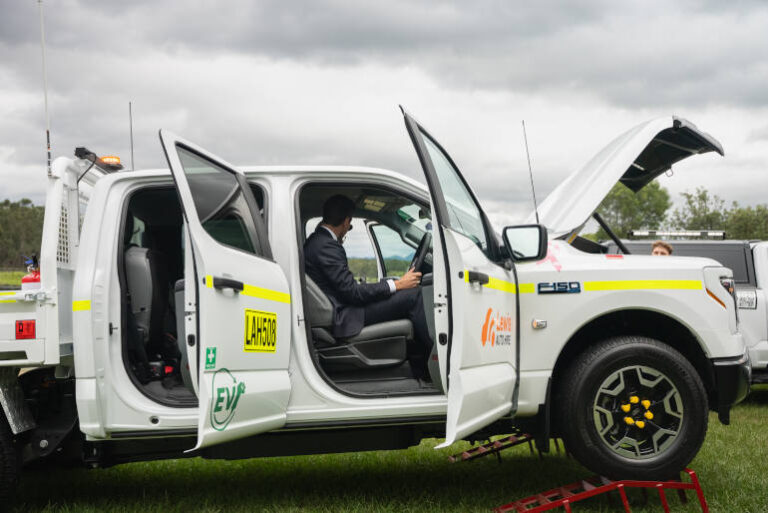The F-150 Lightning has already made headlines as one of the most powerful and advanced electric utilities on the market, but its latest iteration—designed and launched in Australia by AUSEV—represents a shift from potential to practical. This new model, aimed squarely at the mining and heavy-duty commercial fleet sectors, goes far beyond just converting the vehicle to right-hand drive. It showcases what local engineering and supply chain collaboration can do to make a global vehicle truly work for Australian conditions.
Edward Kocwa, CEO of Bosscap Group, the parent company behind AUSEV, explained to Fleet News Group that the official launch held recently in Queensland marked a significant milestone—not just for the vehicle itself, but for the industry. “For us, it was the launch of the mining spec,” said Kocwa. “We unveiled the finished product, ready to go for the mining sector, and also commercial and fleet use.”
While earlier F-150 Lightnings offered impressive EV credentials, the new version has been shaped through a year of hands-on trials and upfit refinement. “Getting the trays sorted, resolving the 12-volt battery challenges in EVs, integrating solar panels, auxiliary batteries, and meeting the varied safety requirements of mining operations—these have been the real achievements of the past year,” Kocwa said.
Unlike typical upfits in the U.S. that are plug-and-play due to OEM collaboration, the Australian version required local innovation. “A lot of the upfit has come from local suppliers,” he noted. “Things like steel trays, high-voltage isolation, and safety regulations are just different here. We’ve had to develop much of it ourselves.”
Crucially, the local engineering team didn’t just bolt on accessories. “We’ve got all the blind spot and driver assistance tech working, despite the tray changes. That’s the benefit of having domestic engineering—our team can work directly with upfitters to ensure everything integrates properly,” said Kocwa.
The F-150 Lightning also brings a new layer of value to fleet operations through its vehicle-to-grid (V2G) capability. Certified for use with the Essential Energy network, it can now serve as a mobile battery, able to power work sites or support grid stability. “It unlocks a whole new model for total cost of ownership,” said Kocwa. “If the power is out, an F-150 Lightning could keep a depot functioning—worth up to $50,000 a day for some businesses.”
Yet even without V2G, the numbers stack up. Kocwa says that any fleet travelling more than 20,000 km annually can start to see savings. “There’s at least $10,000 to $12,000 a year in operational savings. Over five years, that’s up to $60,000—and that’s before factoring in V2G benefits or maintenance savings,” he explained.
Fleet downtime is another key area where EVs like the Lightning shine. “Maintenance isn’t just about service costs,” said Kocwa. “It’s also the lost productivity from taking a vehicle out of service, which can be huge for remote sites. Some locations are 400 km from a service centre—that’s a full-day loss per vehicle.”
With a payload of one tonne and towing capacity up to 4.5 tonnes, the F-150 Lightning meets or exceeds expectations for heavy-duty work. “For short-range towing, EVs are incredibly capable,” said Kocwa. “And the space inside—comfortably seating five adults—makes it more useful than many mid-sized utes.”
Battery options include a 98 kWh standard range and a 131 kWh extended pack (which is actually 144 kWh in usable capacity). “Everyone asks about range first, but the standard range actually drives better behavioural change,” Kocwa said. “It enforces the ‘ABC’ rule—Always Be Charging. Most fleets don’t need more than 300 km a day.”
Kocwa also pointed to a broader economic opportunity tied to supporting Australian manufacturing. “We’re certified as an Australian-owned business. Our upfit work supports local suppliers. With the new government definition requiring 50% Australian ownership, there’s now a stronger case for local procurement,” he said. “A dollar spent with us stays in Australia, creating jobs and building capability.”
The F-150 Lightning may have started life as an American truck, but in the hands of AUSEV and Bosscap Group, it’s becoming a distinctly Australian workhorse. With tailored upfits, V2G capability, and a focus on local economic contribution, the new mining-spec Lightning offers more than just electric torque—it delivers strategic value for fleet operators navigating the next era of transport.






